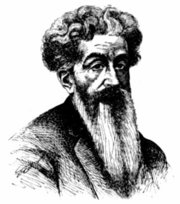|
|
Dr. Ramón Emeterio Betances (April 8, 1827 – September 18, 1898), born in Cabo Rojo, Puerto Rico, was the main leader of the Grito de Lares revolution.
Betances parents were rich land owners in Cabo Rojo. He received his primary and secondary education in the private schools that only the members of the elite society of those days could attend. His mother died when he was a young man and his father sent him to France.
In 1846, Betances obtained his Bachelors degree and he then proceeded to study medicine in Paris. In 1853, he graduated from the University of Paris with the titles of Doctor in Medicine and Surgeon.
When Betances returned to Puerto Rico, one of the first things that he did was to establish a hospital. He worked hard to save many Puerto Ricans from the ravages of the cholera epidemic of the era. He also gave many donations to the poor and was known as the "The Father of the Poor".
Betances believed in the abolition of slavery and founded a clandestine organization called "The Secret Abolitionist Society. The objective of the society was to free children who were slaves, by the sacrament of Baptism. When the child was baptized, Betances would give money to the parents which they in turn used to buy the child's freedom from his master.
The Spanish government, which ruled over Puerto Rico, banished Betances and sent him to exile. Betances fled to the Dominican Republic and then went to New York, where together with Segundo Ruiz Belvis founded "The Revolution Committee of Puerto Rico". Betances and Ruiz returned to the Dominican Republic where they organized an armed expedition that was to invade the island. They also organized revolutionary cells in Puerto Rico, which would be led by leaders such as Manuel Rojas and Mathias Bruckman. Betances instructed Mariana Bracetti to knitt a flag for the revolution using the colors of the Dominican Republic. Eventually all these factors led the way to the abortive insurrection known as the "Grito de Lares". Betances then returned to Paris where he continued to fight for Puerto Rico's independence.
Some of Betances written works include "La Vierge de Borinquen"(1859), and "Les Voyages de Scalado"(1890) in French and "La Botique"(1863) in Spanish.
One of the events that gave Betances a great satisfaction was the abolition of slavery on March 22, 1873 in Puerto Rico.
Betances was awarded the "Legion of Honor" by the French government for his contributions to literature.
Betances died in Nevilly, France and his remains where returned to Puerto Rico in 1920 and buried in his native city, Cabo Rojo.
There is a bust created by the Italian scultor Diego Montano alongside the Grito de Lares revolutionary flag and the Puerto Rican flag in the plaza of the town of Cabo Rojo, which is also named after Betances.
Major works
- La botijuela (1863)
- Las cortesanas en París (1853)
- Washington Haitiano (essay about Alexander Petion, 1871)
- Un premio de Luis XIV (1853)
- Toussaint L'ouverture, los dos indios (1852)
- Los viajes de Scaldado (1890)
- La Vièrge de Borinquén (1859)
See also
External links
- Ramón Emeterio Betances - Library of Congress (http://www.loc.gov/rr/hispanic/1898/betances.html)

